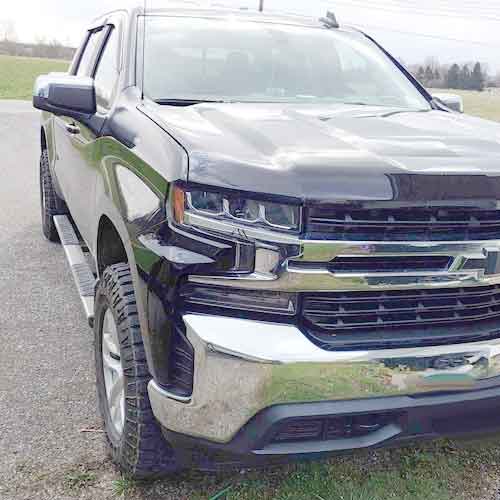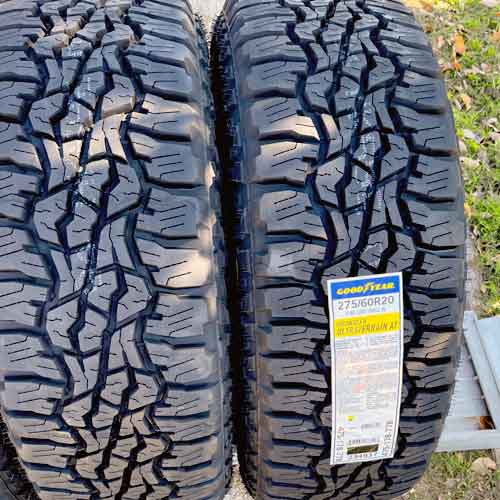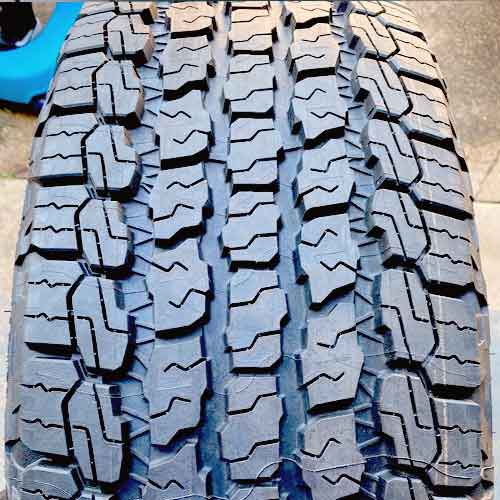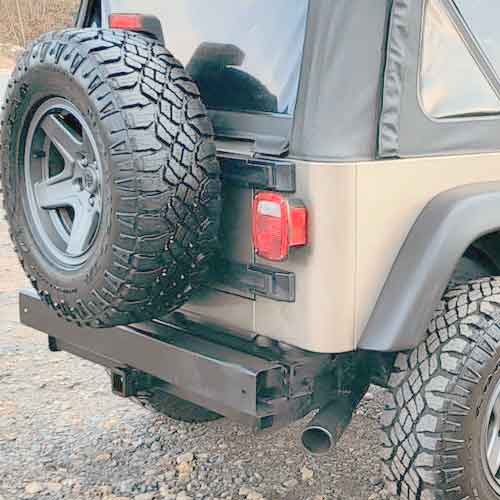Although, all of these Goodyear Wrangler members come in the category of all-terrain tires, and they cater to different types of drivers. The Goodyear Adventure comes as a commercial tire designed for all-weather conditions, while the Goodyear DuraTrac and UltraTerrain A/T are meant for rugged tracks, though they also don’t lack a lot on smooth pavements Let’s check out these tires in details.

In my expert opinion as a tire engineer, the Goodyear Duratrac offers the best experience off road, where I ranked this tire on top for mud evacuation. The Wrangler Adventure on the other side, does best, relatively, on pavements. And the UltraTerrain comes in the middle of these two.
Sizes Comparison
In the following table, please note that, the 3PMSF stands for Three-Peak Mountain Snowflake. This symbol signifies the tire has met the required performance criteria in snow testing to be considered severe snow service-rated.
Moreover, the M+S stands for Mud and Snow, which is basically means, the tire is voided enough.
You can check them out both in details, here.
| Goodyear DuraTrac | Goodyear Wrangler UltraTerrain AT | Goodyear Wrangler Adventure Kevlar | |
|---|---|---|---|
| Rim Sizes | 15 to 22″ | 16 to 20″ | 15 to 20″ |
| Weight Range (lbs) | 35 to 68 | 40 to 70 | 34 to 60 |
| Speed Ratings | Q, S, P, T | S, Q | R, S, T, H |
| Load Ratings | SL to F | SL and E only. | SL, XL, C, E |
| Tread Depth (in 32nds) | 16 – Max 18 | 16 or 18 | 12 or 15 |
| Ratings | 3PMSF, M+S | 3PMSF, M+S | 3PMSF, M+S |
| Treadwear Warranty | 50k miles (Excluding LT sizes) | None | 60k miles |
| No. of Stud-able Lugs (LT sizes) | 16 | Missing Stud-able lugs | Missing Stud-able lugs |
Tread Design
Starting with the Goodyear UltraTerrain.

So If I start form the middle here, the tread basically features 2 ribs here, and they only make 2 wide outer longitudinal channels. Though they also make wild zigzag grooves in the middle as well, as you can see.
The ribs have various lugs in them with sharp edges and full depth siping of slightly interlocking designs.
All these lugs are equipped with reinforced foundations and the grooves they make are embedded with secondary biters (just like you see on Goodyear Duratrac).
Moving towards the shoulders, lugs are different here, and so does the siping pattern. These blocks are bigger, have notches facing the middle area, and have rectilinear siping, though full depth.
And towards outer edges, although they don’t make proper mud scoops, each lug is serrated on itself. And there are various biters on the sidewalls.
Moving towards the Goodyear Wrangler All-Terrain Adventure…

This tire, gives you a 5 rib design, where its tread is more longitudinally aligned.
So the 3 ribs in the middle make very straight vertical channels, where the outer two are slightly wider and carry multiple stone ejectors in between, forming very efficient self cleaning tread.
The middle most lugs are joined up with each other and carry interlocking full depth sipes, allowing for directional grip on both dry and wet roads, whereas the surrounding ribs have blocks at an angle.
They also have slightly more biters and have bigger lateral grooves.
Though the most highlighting part of the tread is the shoulder area.
These shoulder lugs carry multiple sipes in all directions and they are made stable too as they join up on the sidewalls.
Lastly, moving towards the beast. The Wrangler DuraTrac is an amazing tire that’s designed with blocks featuring saw tooth teeth and joined together by a dual compound layer for maximum toughness.

The shoulder lugs are highly voided and run in pairs that are joined together from beneath, creating huge gaps that make it a hybrid tire with the shoulders of a mud tire.
These blocks have deep, full depth siping with a wave-like pattern that provides incredible flexibility.
In the wider grooves, the tire has small biters known as Tractive Groove Technology, a mini, secondary tread pattern, if you will.
And the middle ribs are smaller but have the same amazing features, although the siping is less interlocking.
These central lugs are closely packed together and offer fantastic directional stability, and the chamfered edges ensure the ribs don’t push against each other during cornering and heavy braking.
Grip Comparison
Tires exhibiting less tread, or a “bald” pattern, typically face traction challenges due to inadequate rubber-to-surface interaction, (stating the obvious here).
As such, the Goodyear DuraTrac, characterized by pronounced tread voids, struggles in this particular facet.
In contrast, the Goodyear Wrangler AT Adventure, explicitly engineered for versatile terrain usage (inclusive of on and off-road environments), demonstrates superior road adhesion.
This tire basically comprises a continuous center rib, and its surrounding tread lugs are more densely arrayed relative to other models.
In addition to this, all tread lugs are undergirded by sturdy bases, ensuring not just a heightened level of road contact, but also crucial stability.
The Goodyear UltraTerrain, coming in between the hybrid and all-terrain, slightly under-performs relative to the AT Adventure.
To put things in perspective, the UltraTerrain’s braking distance (on average), is approximately a foot longer compared to Adventure, though it’s a foot shorter compared to DuraTrac.
Handling and Lateral Traction
The effectiveness of a tire’s handling is contingent on its tread pliability and shoulder lug architecture. Consequently, the Goodyear Wrangler AT Adventure stands out in terms of handling performance.
This tire offers shoulders which have robust foundational supports, (in essence, all lugs are situated atop a secondary layer of rubber).
This structure basically mitigates excessive lug displacement during cornering, facilitating a swift steering response, and in return improving overall handling.
On the other side, the Goodyear DuraTrac, employing a more pliant compound with such bold shoulders gets to be more susceptible to overall oversteering and understeering
Furthermore, its extensively spaced lugs compromise the tread-to-ground interaction, which inhibits handling efficiency.
Lastly talking about the Goodyear UltraTerrain. This tire despite the absence of lug support structures, features more closely spaced lugs, delivering superior performance relative to its hybrid terrain brother, the DuraTrac.
Side Note: During cornering, the tire’s weight shifts towards the shoulders, resulting in increased flexing and bending of the lugs. This leads to a delay and a tendency for understeering and oversteering, slowing down the steering response and ultimately affecting overall handling effectiveness.
Snow Performance
Starting with the Goodyear Wrangler AT Adventure and UltraTerrain, both of these tires are really impressive on snowy terrains.
Both these tires have a 3-peak mountain snowflake rating (like the Goodyear DuraTrac), and they have lots of features across the tread to grip the snow.
Though still, in my tests, the Goodyear UltraTerrain was the best in snow, as it featured superior snow holding properties.
Its tread basically features a lot of in-groove notches, that grip the ground and lodge in snow, which later from snow to snow contact.
This type of contact is significant, and snowflakes stick better on each other compared to rubber.
The DuraTrac, on the other hand, is good for deeper snow. Its thicker lugs work like paddles, scooping the snow out of the way and helping the vehicle move forward.
Off-Road Performance
Off-road, it’s expected that the Goodyear DuraTrac would perform better, but how do the other less aggressive tires fare? Let’s examine by considering all the terrain types, they were tested on.
Desert Performance
When dealing with sandy surfaces, tires should be able to stay on top, or “float”, without sinking too much.
Does this mean that heavier tires would perform worse because they might sink more easily?
Not really…
It’s about the density of the tire, not the weight. For example, the Goodyear DuraTrac, even though it’s the heaviest, floats well because its sidewall lugs expand when you reduce the air pressure, which is always a good idea.
The Goodyear UltraTerrain is also good at floating on sand because of its U-shaped sidewall lugs. But because it has smaller mud scoops, it can’t move through the sand as well as some other tires that have a more aggressive design.
The Wrangler AT Adventure is not as good in this area because it doesn’t have sidewall lugs, and its sharper shoulders (that are staggered) can make it more likely to sink into soft surfaces.
Gravelly Roads
When driving on roads covered with dirt and rocks, it’s not just about how well the tires resist cuts, (though its still an important part). But it’s also important for the tires to push out, or “eject”, sharp rocks so they don’t interfere with the tire’s grip.
(Basically, stuck rocks come in between the rubber and the surface, and so proper grip isn’t achieved).
Out of all the tires, the Goodyear DuraTrac, which has strong stone ejection properties, performs the best. Its design has larger voids, which helps keep out dirt and rocks, and any debris that does get in is quickly pushed out by its Tractive Grooves Technology.
This tech (already explained in the tread design section), is basically a name for mini tread pattern seen on the outer circumferential grooves of the tire, and they provide amazing off road traction.
The Goodyear UltraTerrain don’t do so well in this department, but its still better compared to Goodyear Adventure.
Climbing Rocks
Rock climbing can be tough, and sometimes the truck might tip over if the tires don’t have enough side-ways grip. So, having a tire with multiple gripping angles is crucial here.
Now out of all tires, the DuraTrac offers bigger groove mouth, which can can grab onto the rocky surface better. Moreover, the tire offers better sidewalls lugs which really help with pulling/climbing with reduced air pressure.
On the other hand, the Goodyear UltraTerrain is also pretty good on rocks. Its V-shaped lugs on the sides, combined with numerous in groove notches in the middle offer superior overall traction, compared to AT Adventure.
The Goodyear Adventure, basically lacks in providing multi-angled grip, due to it’s longitudinally streamlined lugs. Moreover, the tire is also missing with aggressive enough sidewall lugs.
Side Note: Durability is also a crucial factor on rocky terrains, but all of these tires offer similar toughness, with all of them having 2 ply sidewalls.
Muddy Trails
When driving on mud, a tire needs to be able to do two things, shovel the mud backwards, and self clean it form its tread.
And out of all tires, the Wrangler AT Adventure isn’t good at doing either of these things as its missing with staggered shoulders (which offers shoveling), and rib that runs down the center is closed up, so it can’t get rid of mud fast enough, especially to the sides.
Here, the UltraTerrain is a bit better with its interconnected voids and scoops on the outside lugs for shoveling. But the DuraTrac is definitely the best of these tires for mud.
In fact I rated, the Duratrac, the best, when it comes to muddy terrains.
The tire has a design with a lot of voids, which allows the mud to get out easily. Its thick scoops for shoveling mud, combined with its lugs on the sides, give it excellent ability to move through mud.
Conclusion
This analysis focused on evaluating the performance of Goodyear DuraTrac, Wrangler AT Adventure, and UltraTerrain variants. Here all the factors including grip, handling, and performance across varying terrains were examined.
The Wrangler AT Adventure demonstrated superior road adhesion and handling due to its specific design features. In other words, its a better on-road tire, with its streamlined longitudinally aligned lugs.
The DuraTrac, although under-performed in grip and handling, excelled off-road, performing well in desert and gravelly conditions.
Performance in rocky and muddy conditions favored the DuraTrac and UltraTerrain, while snow performance was strongest in the UltraTerrain tire.